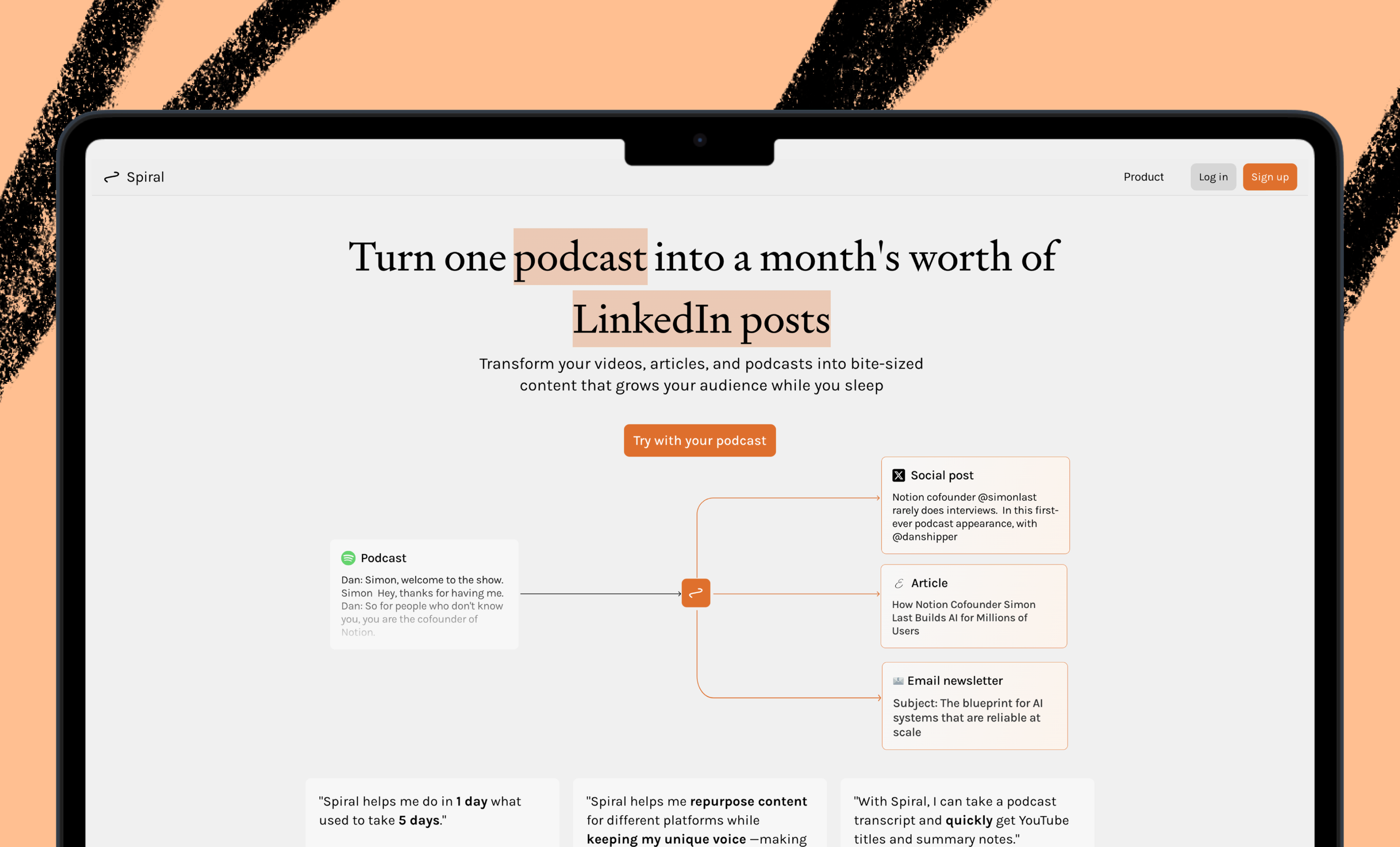.37.18_AM.png)
What happens when a content marketer starts making GitHub pull requests, building AI agents that tweet in their CEO's voice, and constructing systems that reformat and distribute writing across platforms? They transform into something new—a “content engineer” (that's distinct from “context engineer”). Shreeda Segan walks us through her own professional metamorphosis, showing how she built an AI system that freed up hours she used to spend ghostwriting each week. The result was a whole new career path—one that comes with ample time to focus on what humans do best.—Kate Lee
Six months ago, I was ghostwriting tweets for my CEO. Last month, I shipped an AI agent that does it for me.
I used to spend hours crafting changelogs, blog posts, and tweetstorms in my CEO’s voice. Often we’d “pair-write.” I would send him a first draft and we’d jump on a call together while he made edits to the text, sharing his rationale behind every tweak.
Last month, I built an AI agent that could tweet like him—not just mimic his style, but learn from his best posts and get better with every edit I made. I wasn't just a writer anymore. I was becoming something new: a content engineer.
I've been working for Mastra.ai, an open-source programming framework that gives developers access to the building blocks of AI engineering, since last fall, witnessing firsthand how traditional content strategy and marketing roles are transforming. This is the future of content marketing: not just creating content, but building systems that scale your writing across channels, formats, and audiences.
Just as one AI engineer can now do the work of three or four traditional engineers, a content engineer uses automation to produce content at the scale of multiple writers—while maintaining quality and voice consistency. In other words, AI has created a new type of creative professional who builds systems for communication instead of just writing. Here's why that transformation matters and, if you’re interested, how to go through it yourself.
A clean computer that stays clean
Thinkers of all sorts need open space to develop their ideas. But if you’re like us, you probably find that your digital spaces are cluttered more often than not, with Screenshots, PDFs, and downloads. Our AI tool Sparkle cleans your computer so you don’t have to.
Finding my role—and naming it
I've been writing in journals or online since I was 8 years old. It's how I process complex thoughts, understand the world, and express what I can't say out loud. After studying both writing and computer science in college, I spent three years as a brand marketer at online banking platform Mercury.
But during my contract work as a writer with Mastra.ai, something shifted in how I understood my role. I found myself making my first pull requests in GitHub, using Cursor as a co-writer for technical documents, and learning frameworks like Mastra itself. I discovered that the most interesting work was happening in the spaces where writing, AI, and building intersected.
When the CEO offered to bring me on full time this April, he had Rippling open on his laptop, waiting for me to define my own role. I pitched "content engineer" almost as a joke, because I’d never heard of such a title, but also because it echoed titles like “prompt engineer” and “AI engineer.” And it stuck. My official mandate (as I later wrote in my job description) was to write and use AI to build systems to scale the same content across platforms.
I soon discovered I wasn't alone in recognizing this shift. Stedi, a healthtech company, had independently arrived at the same role: It was searching for a content engineer, which it defined as someone who can use AI to go through all their internal documentation and meeting notes and build systems that turn this information into publishable content.
The role crystallized after our CEO said he wanted to share more insights on X but didn't have time to draft every thread himself. Over several months, I collected his best tweets and used Cursor and Mastra to build an agent that learned his voice. Using Mastra's model context protocol (MCP) support and documentation server, I connected Mastra with Typefully to create a workflow that drafts tweets in his style—mostly lowercase, no emojis, speaking directly to developers without any marketing-speak or corporate fluff.
The system saves me 5-6 hours per week. Instead of ghostwriting from scratch, I edit AI-generated drafts that improve with every interaction and learn from my feedback. The edits don't disappear—they become training data for the next iteration. It's not perfect, but it constantly gets better.
As I’ve grown more confident, I’ve found other efficiencies, too: I utilize Cursor to write weekly copy for our changelog by checking it directly against our codebase, as well as templates and prompts shared across our team that help us maintain consistent tone and structure when we write case studies. Each tool saves hours and helps our ideas travel further.
Writing as creative direction
This work has taught me something crucial: AI engineering and writing are both iterative crafts. You try something, scrap it, try another approach, see how it looks, and iterate again. It's not the deterministic, logical process you might expect from coding—it's messier and more creative.
The craftsmanship of writing has moved up the abstraction ladder. Generative AI excels at understanding writing styles, voices, and tones. The craft happens at the level of idea generation itself, and in how effectively you can articulate those ideas to AI through prompting. To be a writer is to pay attention to and care about novel insights, know how to present them in the right context, and communicate them well enough to LLMs through prompting such that they can produce a good first draft.
Writers previously had to manually adapt their work for each platform—blog, newsletter, tweet, thread, LinkedIn post. With AI, you can produce content in the form truest to you and your needs—a long essay, a voice memo, a technical document—and let AI handle the distribution: translating, summarizing, and adapting your work across platforms. The original remains the source of truth; the AI-generated versions merely become refit for distribution, not replacement.
Instead of spending hours reformatting the same ideas, I can now focus on generating new insights and strategies, like interviewing users for case studies and exploring new formats for telling customer stories, as well as learning new skills like website design. Multi-channel scaling happens automatically, freeing up time for the work that requires human judgment and creativity.
There are limits, of course. The best writing draws from lived experience and observation—insights that emerge from paying attention to the world in ways AI cannot. Human craft remains essential in knowing when to let AI take over versus when to maintain your touch.
How to become a content engineer
If you find yourself drawn to the intersection of writing and technology, you might already be suited for content engineering. Here's how to make the transition:
Step 1: Learn technical skills
Start with "vibe coding"—the informal, experimental approach to programming that's perfect for writers. Resources like Nat Eliason's course or Mastra workshops make this more accessible than ever. You don't need to become a full developer; you need to be comfortable with:
- Interacting with software via basic command line operations
- Understanding APIs and how systems connect
- Reading documentation and implementing examples
- Using AI coding assistants like Cursor
Step 2: Start with small automation projects
Begin by automating your own repetitive tasks:
- Build a blog-post-to-tweet-generator. Use an AI engineering framework (such as Mastra) to define an agent that transforms blog posts into tweets. In my case, I created a new project, installed a fresh Mastra instance, opted to enable the Mastra MCP documentation server when asked, and asked Cursor to change the default agent example into a tweet drafter. MCP can also connect tools like Zapier and Typefully to your project so that tweets get auto-drafted for posting.
- Create templated prompts for your brand voice so you maintain voice consistency across content types.
- Use RAG, MCP, or Cursor to train models on your brand voice.
- Experiment with connecting different tools together with MCP (like I did with Typefully) so your agent can complete tasks for you.
Step 3: Position yourself for content engineering roles
- Document your automation projects and their impact (time saved, consistency improved).
- Contribute to open-source documentation or create technical content.
- Network with both writers and developers—you're bridging these worlds.
- Look for companies building AI tools or those embracing AI-first content strategies.
The key mindset shift: Let go of the traditional attachment to prose-as-craft. New worlds demand new skills, and the ability to build systems that scale your ideas is becoming as important as the ideas themselves.
The title of content engineer might feel made-up now, but so did "social media manager" 15 years ago. If you're willing to step into a role before it has a clear definition—to work in the spaces where disciplines blur—you might find yourself helping to define what content creation looks like in the AI age.
Shreeda Segan is a content engineer at Mastra.ai. She also writes for Arena and has written profiles for Meridian.
To read more essays like this, subscribe to Every, and follow us on X at @every and on LinkedIn.
We build AI tools for readers like you. Automate repeat writing with Spiral. Organize files automatically with Sparkle. Deliver yourself from email with Cora.
We also do AI training, adoption, and innovation for companies. Work with us to bring AI into your organization.
Get paid for sharing Every with your friends. Join our referral program.
Ideas and Apps to
Thrive in the AI Age
The essential toolkit for those shaping the future
"This might be the best value you
can get from an AI subscription."
- Jay S.
Join 100,000+ leaders, builders, and innovators

Email address
Already have an account? Sign in
What is included in a subscription?
Daily insights from AI pioneers + early access to powerful AI tools






Comments
Don't have an account? Sign up!